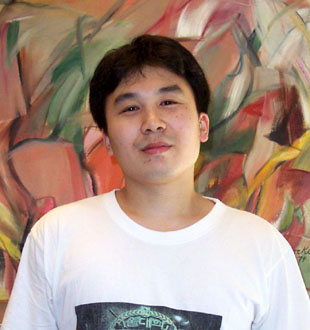
Department of Chemical Engineering
Room 66-463
Massachusetts Institute of Technology
77 Massachusetts
Avenue
Cambridge, MA 02139-4307 USA
Telephone 617 253-6490
Email: chlim@mit.edu
Chang Hoon Lim
Graduate Research Assistant
B.S., Chemical Engineering, Seoul National University 2000
Research Interests
Kinetic analysis of intracellular levels of reactive nitrogen species derived from NO
Nitric oxide (NO), which is synthesized throughout the body, is a regulator of various physiological functions and a component of the nonspecific immune response. To reliably assess the cytotoxicity of NO, a previous student in our group (Chen Wang) developed a delivery system to expose cells to known, constant levels of NO over long periods of time, using gas-permeable tubing. But this system develops high local concentrations of NO2 and N2O3 near the NO delivery tubing -- what we term "hot spots" -- which can significantly affect the observable kinetics of certain reactions. In addition to seeking a solution to that problem, we want to develop a NO2 delivery system to investigate the specific effects of NO2, in the absence of NO and N2O3.
Also, it is well known that the high solubility of NO and O2 in hydrophobic media greatly accelerates NO oxidation, but the resulting NO2 and N2O3 chemistry is not well understood. Even though most of the individual chemical reactions of reactive nitrogen species (RNS) have been kinetically well characterized under certain conditions, extrapolation of the results to cells or biological solutions is sometimes questionable. Models have been proposed to predict intracellular levels of NO and related RNS. For instance, a previous student (Nitesh Nalwaya) developed a reaction-diffusion model to describe the intracellular concentration of peroxynitrite in cells exposed to NO and/or peroxynitrite. But this model focused only on peroxynitrite, not NO2 and N2O3. In my research, intracellular levels of NO2 and N2O3 will be predicted in lipid suspensions and cells using a greatly expanded kinetic model, which includes all RNS, cellular antioxidants such as glutathione, and various targets for nitrosation or nitration reactions. Experiments will be performed to test the kinetic predictions in vitro.
Personal Interests
My research interest in this specific area is a natural consequence of my passion for mathematics, physics and chemistry. I am interested in combining these sciences with chemical engineering principles to solve problems in the life sciences. In this respect, the Deen group is the perfect place in the MIT Chemical Engineering Department. Our work on NO involves collaborations also with researchers whose backgrounds are in applied biology and medicine. Thus, it is very interdisciplinary. Eventually in my career, I hope to use network physics to reduce various biological phenomena to a few fundamental principles.